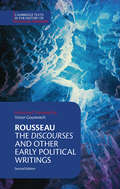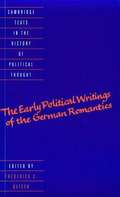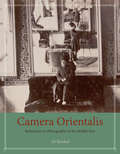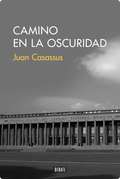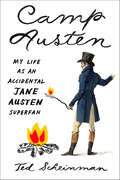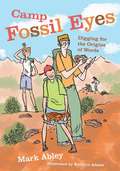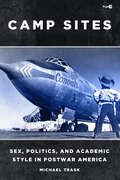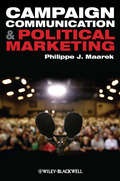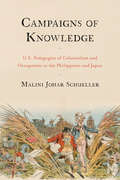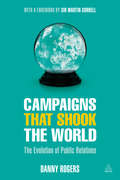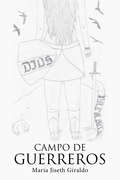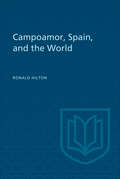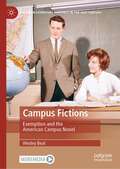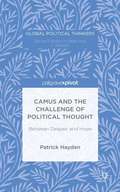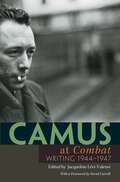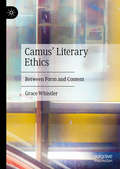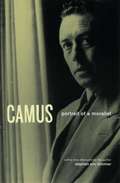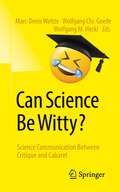- Table View
- List View
Cambridge Texts in the History of Political Thought: Rousseau (Cambridge Texts In The History Of Political Thought Ser.)
by Victor GourevitchCambridge Texts in the History of Political Thought: The Early Political Writings of the German Romantics
by Frederick C. BeiserThe early romantics had an ambition still relevant today: to find a middle path between conservatism and liberalism, between a community ethic and individual freedom. Frederick Beiser's edition comprises all kinds of texts, from essays to jottings from notebooks. All have been translated anew, many for the first time.
Camera Orientalis: Reflections on Photography of the Middle East
by Ali BehdadIn the decades after its invention in 1839, photography was inextricably linked to the Middle East. Introduced as a crucial tool for Egyptologists and Orientalists who needed to document their archaeological findings, the photograph was easier and faster to produce in intense Middle Eastern light—making the region one of the original sites for the practice of photography. A pioneering study of this intertwined history, Camera Orientalis traces the Middle East’s influences on photography’s evolution, as well as photography’s effect on Europe’s view of “the Orient.” Considering a range of Western and Middle Eastern archival material from the late nineteenth and early twentieth centuries, Ali Behdad offers a rich account of how photography transformed Europe’s distinctly Orientalist vision into what seemed objective fact, a transformation that proved central to the project of European colonialism. At the same time, Orientalism was useful for photographers from both regions, as it gave them a set of conventions by which to frame exotic Middle Eastern cultures for Western audiences. Behdad also shows how Middle Eastern audiences embraced photography as a way to foreground status and patriarchal values while also exoticizing other social classes. An important examination of previously overlooked European and Middle Eastern photographers and studios, Camera Orientalis demonstrates that, far from being a one-sided European development, Orientalist photography was the product of rich cultural contact between the East and the West.
Camino en la oscuridad
by Cassasus JuanJuan Casassus, en este obra, se atreve a reflexionar sobre la desaparición y tortura -la cuales él sufrió- desde un punto de vista espiritual. En esta impactante obra, el autor decide develar los hechos que le ocurrieron durante el periodo en que estuvo desaparecido. Es un relato donde el horror no alcanza para describir lo que él y otros miles de chilenos sufrieron como consecuencia de la persecución política que se desató tras el golpe de Estado. En su caso, sin embargo, también fue una experiencia que lo llevó a fortalecerse interiormente, gracias a un trabajo espiritual que desarrolló a través de la meditación en las celdas en las que estuvo confinado. Camino en la oscuridad es una exploración personal y una reflexión sobre la condición humana. Es un libro de una profundidad que sorprende y, asimismo, un testimonio capital de los hechos trágicos que tuvieron lugar en Chile.
Camp Austen: My Life as an Accidental Jane Austen Superfan
by Ted ScheinmanA raucous tour through the world of Mr. Darcy imitations, tailored gowns, and tipsy ballroom dancingThe son of a devoted Jane Austen scholar, Ted Scheinman spent his childhood summers eating Yorkshire pudding, singing in an Anglican choir, and watching Laurence Olivier as Mr. Darcy. Determined to leave his mother’s world behind, he nonetheless found himself in grad school organizing the first ever UNC-Chapel Hill Jane Austen Summer Camp, a weekend-long event that sits somewhere between an academic conference and superfan extravaganza.While the long tradition of Austen devotees includes the likes of Henry James and E. M. Forster, it is at the conferences and reenactments where Janeism truly lives. In Camp Austen, Scheinman tells the story of his indoctrination into this enthusiastic world and his struggle to shake his mother’s influence while navigating hasty theatrical adaptations, undaunted scholars in cravats, and unseemly petticoat fittings. In a haze of morning crumpets and restrictive tights, Scheinman delivers a hilarious and poignant survey of one of the most enduring and passionate literary coteries in history. Combining clandestine journalism with frank memoir, academic savvy with insider knowledge, Camp Austen is perhaps the most comprehensive study of Austen that can also be read in a single sitting. Brimming with stockings, culinary etiquette, and scandalous dance partners, this is summer camp like you’ve never seen it before.
Camp Fossil Eyes: Digging for the Origins of Words
by Mark AbleyIn this fanciful book about etymology, 15-year-old Jill Boswell and her 13-year-old brother, Alex, are sent to summer camp in a bizarre badlands region -- the only place in the world where words are fossilized in rock.
Camp Sites: Sex, Politics, and Academic Style in Postwar America
by Michael TraskReading across the disciplines of the mid-century university, this book argues that the political shift in postwar America from consensus liberalism to New Left radicalism entailed as many continuities as ruptures. Both Cold War liberals and radicals understood the university as a privileged site for "doing politics," and both exiled homosexuality from the political ideals each group favored. Liberals, who advanced a politics of style over substance, saw gay people as unable to separate the two, as incapable of maintaining the opportunistic suspension of disbelief on which a tough-minded liberalism depended. Radicals, committed to a politics of authenticity, saw gay people as hopelessly beholden to the role-playing and duplicity that the radicals condemned in their liberal forebears. Camp Sitesconsiders key themes of postwar culture, from the conflict between performance and authenticity to the rise of the meritocracy, through the lens of camp, the underground sensibility of pre-Stonewall gay life. In so doing, it argues that our basic assumptions about the social style of the postwar milieu are deeply informed by certain presuppositions about homosexual experience and identity, and that these presuppositions remain stubbornly entrenched despite our post-Stonewall consciousness-raising.
Campaign Communication and Political Marketing
by Philippe J. MaarekCampaign Communication and Political Marketing is a comprehensive, internationalist study of the modern political campaign. It indexes and explains their integral components, strategies, and tactics. Offers comparative analyses of campaigns from country to country Covers topics such as advertising strategy, demography, the effect of campaign finance regulation on funding, and more Draws on a variety of international case studies including the campaigns of Barack Obama and Nicolas Sarkozy Analyses the impact of digital media and 24/7 news cycle on campaign conduct
Campaigns of Knowledge: U.S. Pedagogies of Colonialism and Occupation in the Philippines and Japan (Asian American History & Cultu #204)
by Malini Johar SchuellerThe creation of a new school system in the Philippines in 1898 and educational reforms in occupied Japan, both with stated goals of democratization, speaks to a singular vision of America as savior, following its politics of violence with benevolent recuperation. The pedagogy of recovery—in which schooling was central and natives were forced to accept empire through education—might have shown how Americans could be good occupiers, but it also created projects of Orientalist racial management: Filipinos had to be educated and civilized, while the Japanese had to be reeducated and “de-civilized.” In Campaigns of Knowledge, Malini Schueller contrapuntally reads state-sanctioned proclamations, educational agendas, and school textbooks alongside political cartoons, novels, short stories, and films to demonstrate how the U.S. tutelary project was rerouted, appropriated, reinterpreted, and resisted. In doing so, she highlights how schooling was conceived as a process of subjectification, creating particular modes of thought, behaviors, aspirations, and desires that would render the natives docile subjects amenable to American-style colonialism in the Philippines and occupation in Japan.
Campaigns that Shook the World
by Danny RogersOver the past four decades, a series of PR campaigns have helped to shape popular culture and influence public opinion. Campaigns that Shook the World provides the inside story on the pivotal PR campaigns of the past four decades, following and celebrating the maturation and expansion of the PR industry towards today's practice. It examines ten of these campaigns in detail from the 1970s to the present day, explaining their strategy and tactics, looking at the imagery and icons they created and interviewing the powerful, flamboyant personalities who crafted and executed these seminal projects. Each chapter is built around extended case studies including Thatcherism (1979), New Labour, The Royal Family, The Rolling Stones (1981), David Beckham, London 2012, Product [RED], The Obama Campaign (2008) and Dove Real Beauty. Featuring campaigns by Saatchi & Saatchi, Bell Pottinger, Ogilvy, Freuds, Pitch and other well-known agencies, Campaigns that Shook the World grapples with PR's uneasy place at the nexus of politics and celebrity, holding the best campaigns up to scrutiny and showcasing just how powerful PR can be as an instrument of change, for the good, and at times for the less than good. It contains insights from Alastair Campbell, Lord Tim Bell, Alan Edwards, Paddy Harverson, Matthew Freud and many others.
Campo de guerreros
by Maria Jiseth Giraldo«Toma tus armas y pon la frente bien en alto, porque la batalla inicia y debes ganar la guerra que desde que naciste inició.»Maria Jiseth Giraldo Campo de guerreros es un reflejo de aquella batalla interior que cada uno libra día a día, con la diferencia de que al igual que la de los demás, tiene sus propios enemigos, aliados y un sin fin de batallas particulares libradas según la forma de proceder de cada cual. Maria Fernanda Scraus es una mujer que a lo largo de su vida se enfrenta a enfermedades, amores y desamores, vida y muerte. Poniéndose cara a cara con ellos de especial forma. Teniendo como únicos aliados a Dios, su madre, hermanos, amigas, y al amor de su vida.
Campo de retamas: Pecios reunidos
by Rafael Sánchez FerlosioEl más grande escritor vivo en lengua castellana. «Uno de los libros más hermosos, inquietantes y profundos que se han publicado durante las últimas décadas en lengua castellana.»Fernando Savater El diccionario de María Moliner define «pecio» como «resto de una nave naufragada o de lo que iba en ella». Al llamar así a sus apuntes breves, Rafael Sánchez Ferlosio parece sugerir que, lejos de aspirar a la «sentenciosa lapidariedad» de los aforismos, estos textos testimonian más bien los naufragios de una voluntad que -por inconstancia, pereza, impotencia, o simplemente por una recalcitrante desconfianza hacia «la estúpida arrogancia del convencimiento»- ha desistido del esfuerzo superior de perseguir un razonamiento hasta sus últimas consecuencias, conformándose con su sola silueta, su simple amago o fragmento. Los pecios no obedecen a una fórmula homogénea: mezclan reflexiones, esbozos ensayísticos, recuerdos, comentarios, epigramas, donaires, apólogos, poemas... Ingrávidos por naturaleza, permiten adentrarse sin dificultad en las principales obsesiones de Ferlosio, desplegándose en una panoplia de registros que va del humor al lirismo, de la indignación a la ironía, de lo concluyente a lo especulativo. Reseñas:«Entre los autores de mi generación o de las anteriores, sólo me interesa Ferlosio, que es el mejor escritor español.»Juan Benet «Si se me pidiese un nombre, uno solo, entre los surgidos en la literatura española de posguerra, con categoría suficiente para afrontar la inmortalidad literaria, yo daría, sin vacilar, el de Rafael Sánchez Ferlosio.»Miguel Delibes «El más inmediato reproche que al lector impaciente se le viene a las mientes ante la mayoría de los artículos y ensayos de Rafael Sánchez Ferlosio es el de la prolijidad... Pero en ocasiones Ferlosio también sabe ser voluntaria y hasta voluntariosamente breve. Son estos comprimidos de su maestría -que él suele llamar 'pecios'- lo que algunos de sus lectores impacientes pero devotos preferimos de él.»Fernando Savater «Los pecios de Ferlosio son... ferlosianos. Están escritos como si partiera de cero, del vacío... No sé si alguna vez fueran restos del naufragio, pero ya tienen categoría de género en sí mismos.»Gonzalo Hidalgo Bayal
Campoamor, Spain, and the World
by Ronald HiltonLike the fame of Pardo-Bazán, the reputation of Campoamor has suffered a rapid decline. The renown of the poet was flimsier and more ephermal than that of Spain's most notable woman writer. It contained more enthusiasm and less respect. Most of his prose works and many of his dramas died young, whereas Dõna Emilia's infinitely more copious production was uniformly living and vigorous . The integral value of Pardo-Bazán's work is beyond measure greater than that of Campoamor. Whereas the novelist deserves a splendid rehabilitation, the modicum of praise still accorded to the poet perhaps exceeds his merits. Apart from a few flashes of genius—to be found in his prose works—Campoamor is intelligently ordinary. This characteristic incidentally makes him most valuable for this study. <P><P>Campoamor offers a triple advantage as a lens through which to inspect the Spain of his day. Although he is now considered as a poet, his prose work, buried in oblivion—this is the first study to give it real attention—completes the authors' picture of him as a man who incorporated, in an admittedly ephermal way, all the spiritual and intellectual currents of his epoch: above all, the old religious traditionalism and the conflicting new scientific positivism. That Campoamor represented the feelings and the thoughts of the Spain of his time is proved by the enthusiastic applause with which his fellow-countrymen greeted his works. Finally, without being impeccably well-informed, Campoamor was deeply interested in the history and affairs of the world at large, and constantly strove to allot to Spain its correct place in his Weltanschauung.
Campus Fictions: Exemption and the American Campus Novel (American Literature Readings in the 21st Century)
by Wesley BealCampus Fictions argues that the academic novel balances utopian and regressive tendencies, reinforcing the crises we face in higher learning while simultaneously signposting hope for a worn institution. Whether a bestseller such as Erich Segal ’s romance Love Story (1970) or wonkier fare such as Don DeLillo’s White Noise (1985), the academic novel mystifies the academy not only to a wide public but also—worse—to readers who might describe themselves as sympathetic to higher learning. The book takes an eclectic approach to the academic novel with chapters discussing, for example, the genre’s rampant anti-intellectualism and its work refusals, studying novels such as Ishmael Reed’s Japanese by Spring (1993) and Julie Schumacher’s Dear Committee Members (2014). The book is also accompanied by the “Directory of the American Campus Novel ” file, which tracks the genre by year, by setting, and by other datapoints that readers might make use of. Responding directly to Jeffrey Williams, the renowned scholar of critical university studies who implores faculty to “teach the university,” the book ’s conclusion describes strategies for putting these novels into circulation in the classroom. Through this breadth, Campus Fictions establishes the importance of maintaining hope in the field of critical university studies, which tends toward apocalypticism and perhaps therefore toward disengagement.
Camus and the Challenge of Political Thought: Between Despair And Hope (Global Political Thinkers Ser.)
by Patrick HaydenAlbert Camus was a formative artist, writer and public figure whose work defies conventional labels, and whose legacy is controversial but substantial. His distinctive contribution to modern ethical and political thought remains far from settled. Camus and the Challenge of Political Thought comprehensively yet concisely explores how Camus's compelling ideas of absurdity and rebellion emerged, how his complex political engagements and positions developed, and how his conception of an ethics of limits and measure retains a vital, contemporary resonance in an era of unsettling global politics. Drawing upon the full range of Camus's notebooks, novels, plays and philosophical essays, Hayden shows Camus to be an original political thinker of human dignity and freedom whose life and work sought to navigate between the twin dangers of idealistic optimism and nihilistic despair.
Camus at Combat: Writing 1944-1947
by Albert CamusParis is firing all its ammunition into the August night. Against a vast backdrop of water and stone, on both sides of a river awash with history, freedom's barricades are once again being erected. Once again justice must be redeemed with men's blood.Albert Camus (1913–1960) wrote these words in August 1944, as Paris was being liberated from German occupation. Although best known for his novels including The Stranger and The Plague, it was his vivid descriptions of the horrors of the occupation and his passionate defense of freedom that in fact launched his public fame.Now, for the first time in English, Camus at 'Combat' presents all of Camus' World War II resistance and early postwar writings published in Combat, the resistance newspaper where he served as editor-in-chief and editorial writer between 1944 and 1947. These 165 articles and editorials show how Camus' thinking evolved from support of a revolutionary transformation of postwar society to a wariness of the radical left alongside his longstanding strident opposition to the reactionary right. These are poignant depictions of issues ranging from the liberation, deportation, justice for collaborators, the return of POWs, and food and housing shortages, to the postwar role of international institutions, colonial injustices, and the situation of a free press in democracies. The ideas that shaped the vision of this Nobel-prize winning novelist and essayist are on abundant display.More than half a century after the publication of these writings, they have lost none of their force. They still speak to us about freedom, justice, truth, and democracy.
Camus' Literary Ethics: Between Form and Content
by Grace WhistlerThis book seeks to establish the relevance of Albert Camus’ philosophy and literature to contemporary ethics. By examining Camus’ innovative methods of approaching moral problems, Whistler demonstrates that Camus’ work has much to offer the world of ethics— Camus does philosophy differently, and the insights his methodologies offer could prove invaluable in both ethical theory and practice. Camus sees lived experience and emotion as ineliminable in ethics, and thus he chooses literary methods of communicating moral problems in an attempt to draw positively on these aspects of human morality. Using case studies of Camus’ specific literary methods, including dialogue, myth, mime and syntax, Whistler pinpoints the efficacy of each of Camus’ attempts to flesh-out moral problems, and thus shows just how much contemporary ethics could benefit from such a diversification in method.
Camus: Portrait of a Moralist
by Stephen Eric BronnerCamus' nobility of sentiment, his willingness to engage in the reconstruction of freedom, still offer a welcome antidote to the cynicism and the relativism so common among contemporary intellectuals. The best homage for such a man is less an exhibition of reverence than a critical encounter in which his relevance is not simply taken for granted. This kind of homage is surely what Camus would have wished and it is, just as surely, what this biography seeks to provide.
Can Christianity Cure Obsessive-compulsive Disorder?: A Psychiatrist Explores The Role Of Faith In Treatment
by Ian OsbornObsessive-compulsive disorder (OCD) is a relentless condition, the primary symptom being the occurrence of terrifying ideas, images, and urges that jump into a person's mind and return again and again, despite the individual's attempt to remove them. Christians who suffer from OCD may grapple with additional guilt, as the undesired thoughts are frequently of a spiritual nature. Yet people may be surprised to learn that some of the greatest leaders in Christian history also struggled with this malady. What did they experience? How did they cope? Were they able to overcome these tormenting, often violent, obsessions? Where did God fit into the picture? Ian Osborn shares the personal accounts of Martin Luther, John Bunyan, and Saint Thérèse of Lisieux, as well as his own story, in exploring how faith and science work together to address this complex issue.
Can He See Me?
by Lisa Robinson Cindy PeattieTitle contained within StartUp Phonic Core Program. Not Sold Separately
Can I Have a Word?: A Fun Guide to Winning Word Games
by Nick FawcettCan I Have a Word? is the ultimate strategy book for word-game lovers. It introduces the reader to a host of weird and wacky words that will not only help them to become better word-game players but also enhance their enjoyment of competing. It covers key word-game themes, the mastery of which is vital for success, such as: - Two- and three-letter words- Using a Q, Z, J or X to maximum effect- Dealing with the letter V and other problem tiles- Coping with a rack full of consonants or one heavy in vowels- Making seven- and eight-letter words - Tips for victory.Readers will find this amusing, light-hearted book immeasurably enriches their vocabulary, enabling them, without the drudgery of studying a dictionary, to recall all kinds of unusual and interesting words just when they need them most.
Can I Have a Word?: A Fun Guide to Winning Word Games
by Nick FawcettCan I Have a Word? is the ultimate strategy book for word-game lovers. It introduces the reader to a host of weird and wacky words that will not only help them to become better word-game players but also enhance their enjoyment of competing. It covers key word-game themes, the mastery of which is vital for success, such as: - Two- and three-letter words- Using a Q, Z, J or X to maximum effect- Dealing with the letter V and other problem tiles- Coping with a rack full of consonants or one heavy in vowels- Making seven- and eight-letter words - Tips for victory.Readers will find this amusing, light-hearted book immeasurably enriches their vocabulary, enabling them, without the drudgery of studying a dictionary, to recall all kinds of unusual and interesting words just when they need them most.
Can I Use I?: Because I Hate, Hate, Hate College Writing
by Catherine PrendergastCan I use "I" in my college paper? The short answer: Yes. But keep reading. Even if you don't like college writing--no, even if you hate college writing--this guide will get you through it. <p><p> It offers clear and concise answers to your questions about writing college papers. Find out: What makes a good research question? How do I write a strong thesis statement? What if I don't understand my assignment? How do I write an introduction? How do I answer the "so what" question?
Can Science Be Witty?: Science Communication Between Critique and Cabaret
by Marc-Denis Weitze Wolfgang M. Heckl Wolfgang Chr. Goede"Can science be funny?" takes a close look at an element of modern science communication that is as innovative as it is promising for the future: comedy!Readers are guided through vividly presented academic theory as well as exciting hands-on and best practice examples from renowned practitioners and cabaret artists:- What do sheep's cheese and car tires have in common?- Can laughter break down walls?- How does "Die Anstalt" work?- How does magic create knowledge?- Is there humor in museums?- When a Dalmatian comes to the cash register- Three steps to humor- Serving suggestion for the Holy Spirit- dictatorship of stupidity- And much more!But it's not all just funny. Comedy can also take away some of the biting sharpness of criticism, making it digestible, even palatable, for the addressees."Can Science Be Funny?" navigates between criticism and cabaret, tackling comedy in various guises from different perspectives.22 contributions show how the results of science, research and technology can be brought to the general public in new ways. In particular, they also demonstrate how humour can be used as a critical and questioning force - valuable for all types of communication and helpful so that they come across more shrewdly in the future.
Can Theory Help Translators?: A Dialogue Between the Ivory Tower and the Wordface (Translation Theories Explored #Vol. 9)
by Andrew Chesterman Emma WagnerCan Theory Help Translators? is a dialogue between a theoretical scholar and a professional translator, about the usefulness (if any) of translation theory. The authors argue about the problem of the translator's identity, the history of the translator's role, the translator's visibility, translation types and strategies, translation quality, ethics and translation aids.
